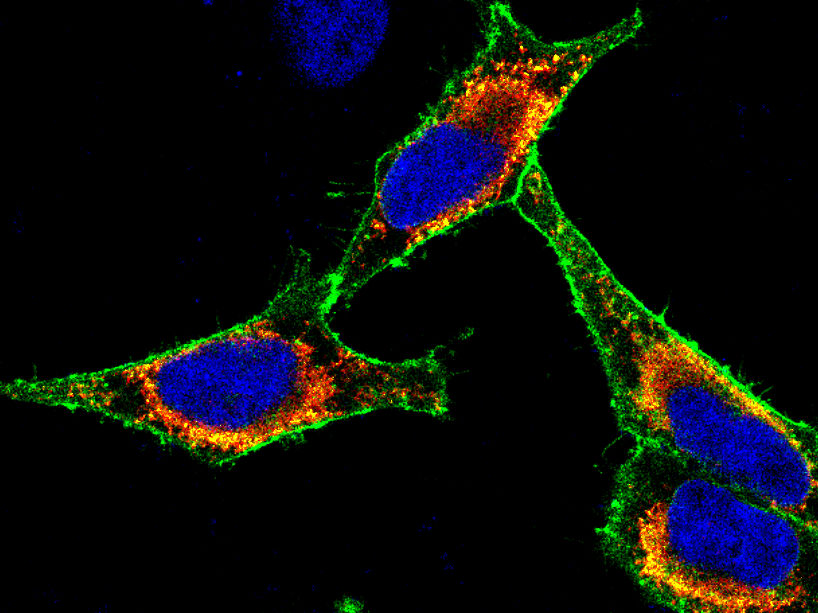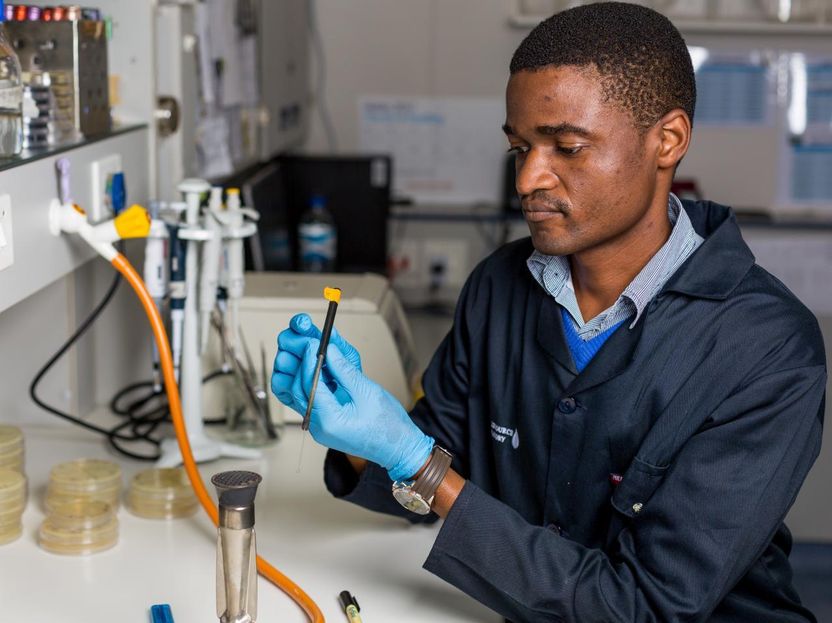New research sheds light on neuronal communication
neurons communicate with each other through specialized structures called synapses. The information is transmitted in the form of synaptic vesicles that contain specific chemical messengers called neurotransmitters. The amount and coordinated release of neurotransmitters regulates synaptic strength which is critical to maintain proper communication between neurons.

Presynaptic deletion of the two G-protein-coupled receptor kinase-interacting proteins (GITs), GIT1 and GIT2, at the mouse calyx of Held, leads to a large increase in the action potential (AP)-evoked release, resulting in increase of synaptic strength
Mónica S. Montesinos and Samuel M. Young Jr./Max Planck Florida Institute for Neuroscience.
To better understand and address a number of neurological disorders, we need a better understanding of the molecular mechanisms that regulate neuronal communication.A new study has revealed an important function of a class of presynaptic proteins previously implicated in neurological disorders in the regulation of synaptic strength.
Synaptic proteins and neuronal transmission
A synapse consists of a presynaptic terminal of one neuron and a postsynaptic terminal of another. The presynaptic terminal stores vesicles containing neurotransmitters, while the postsynaptic terminal contains neurotransmitter receptors. A dense collection of proteins is present in these terminals, however the functional role of many of these proteins remains unknown.
In particular, the G-protein-coupled receptor kinase-interacting proteins (GITs) exert a critical control in synaptic transmission, since deletions of these proteins are lethal or cause sensory deficits and cognitive impairments in mice. In particular, GIT proteins and the pathways they regulate have been implicated in neurological disorders such as Attention Deficit Hyperactivity Disorder (ADHD) and Huntington's Disease. Several studies have demonstrated the role of GITs in the postsynaptic terminal, but very little is known about their role in the presynaptic terminal. Researchers in Samuel Young Jr.'s research team at the Max Planck Florida Institute for Neuroscience set out to investigate the role of GITs in the giant synapse, the calyx of Held, of the auditory system - the optimal model to study the presynaptic terminal independently from the postsynaptic terminal.
New findings
Drs. Samuel Young Jr. and Mónica S. Montesinos and collaborators report for the first time that GIT proteins are critical presynaptic regulators of synaptic strength. This study uncovers previously unknown distinct roles for GIT1 and GIT2 in regulating neurotransmitter release strength, with GIT1 as a specific regulator of presynaptic release probability. This regulation is likely to contribute to the disruptions in neural circuit functions leading to sensory disorders, memory and learning impairment and other neurological disorders.
Future Directions
Future studies of Dr. Samuel Young Jr.'s lab will resolve the mechanisms by which GITs regulate synaptic strength and their roles in the early stages of auditory processing and neurological diseases. "Our work brings significant insight into the understanding of how neuronal communication is regulated, which is essential to understand the cellular and molecular mechanisms of information processing by neuronal circuits and the role of these proteins in the development of neurological diseases," explained Dr. Young.
Original publication
Mónica S. Montesinos, Wei Dong, Kevin Goff, Brati Das, Debbie Guerrero-Given, Robert Schmalzigaug, Richard T. Premont, Rachel Satterfield, Naomi Kamasawa, Samuel M. Young Jr.; "Presynaptic Deletion of GIT Proteins Results in Increased Synaptic Strength at a Mammalian Central Synapse"; Neuron; 2015
Most read news
Original publication
Mónica S. Montesinos, Wei Dong, Kevin Goff, Brati Das, Debbie Guerrero-Given, Robert Schmalzigaug, Richard T. Premont, Rachel Satterfield, Naomi Kamasawa, Samuel M. Young Jr.; "Presynaptic Deletion of GIT Proteins Results in Increased Synaptic Strength at a Mammalian Central Synapse"; Neuron; 2015
Topics
Organizations
Other news from the department science

Get the life science industry in your inbox
By submitting this form you agree that LUMITOS AG will send you the newsletter(s) selected above by email. Your data will not be passed on to third parties. Your data will be stored and processed in accordance with our data protection regulations. LUMITOS may contact you by email for the purpose of advertising or market and opinion surveys. You can revoke your consent at any time without giving reasons to LUMITOS AG, Ernst-Augustin-Str. 2, 12489 Berlin, Germany or by e-mail at revoke@lumitos.com with effect for the future. In addition, each email contains a link to unsubscribe from the corresponding newsletter.
Most read news
More news from our other portals
Last viewed contents

CSIC recovers part of the genome of 2 hunter-gatherer individuals from 7,000 years ago
BioStorage Technologies, Inc., Accelerates European Expansion with Opening of New German Facility
Child_Mental_Health_Research_Trust
USC scientists turn a harmful greenhouse gas into a tool for making pharmaceuticals - New technique finds a use for ozone-destroying chemical waste product
Ariadne Expands Presence in South-East Asia - Genomax Technologies to Distribute Ariadne Software in the Region
All genes in 1 go
Europe challenges USA in stem cell research

Medication-based starvation of cancer cells - Findings on cancer medication reveal protein regulation mechanism
Evotec reaches milestone in integrated drug discovery and development partnership with Aeovian






















































